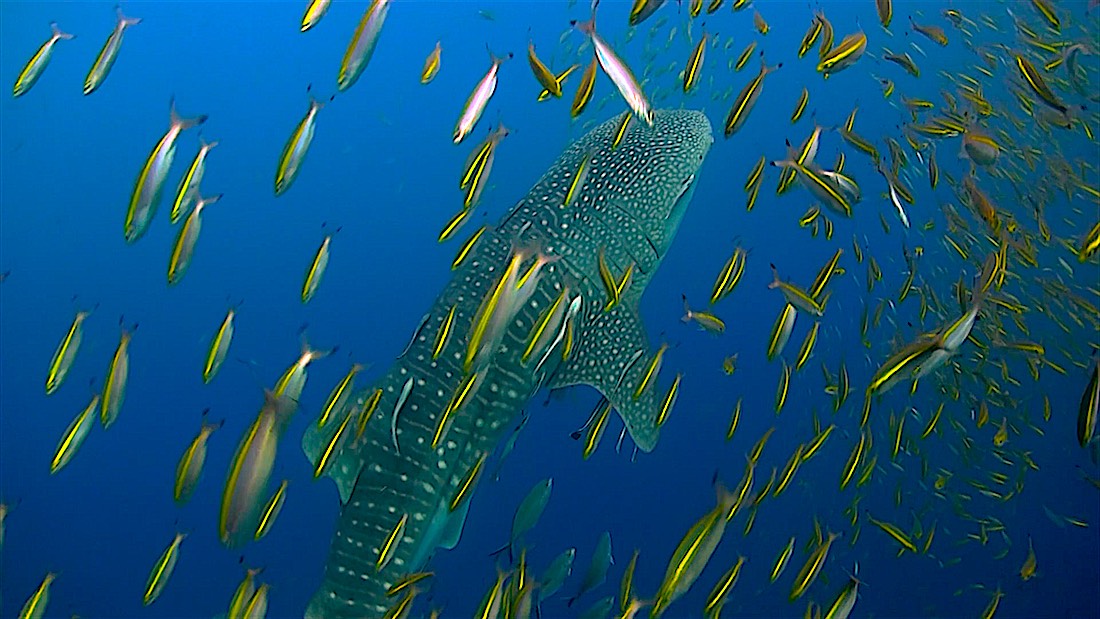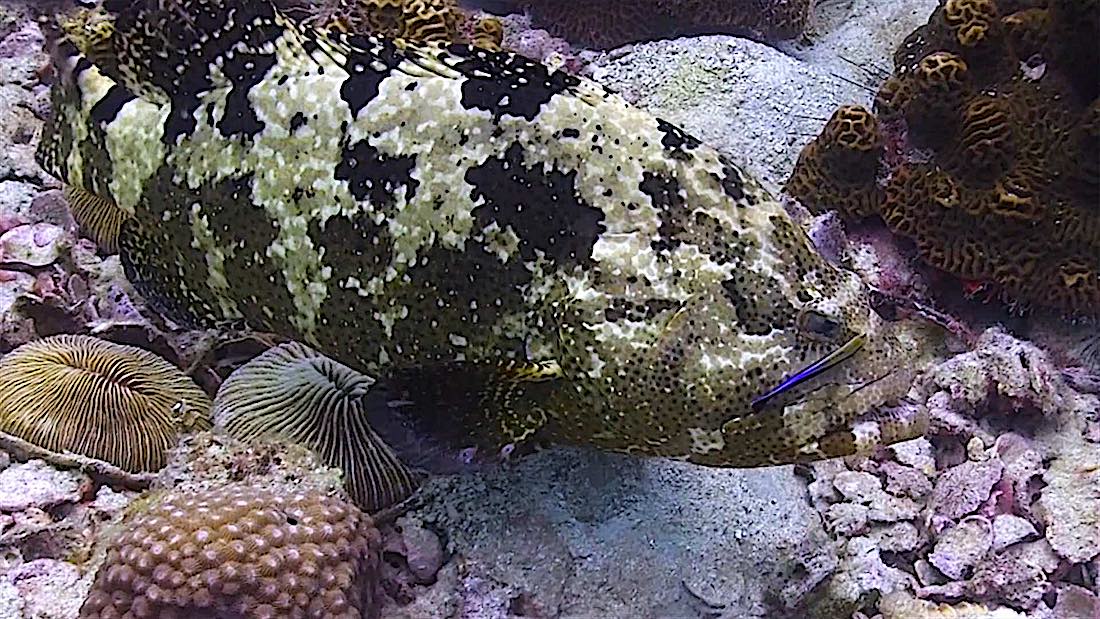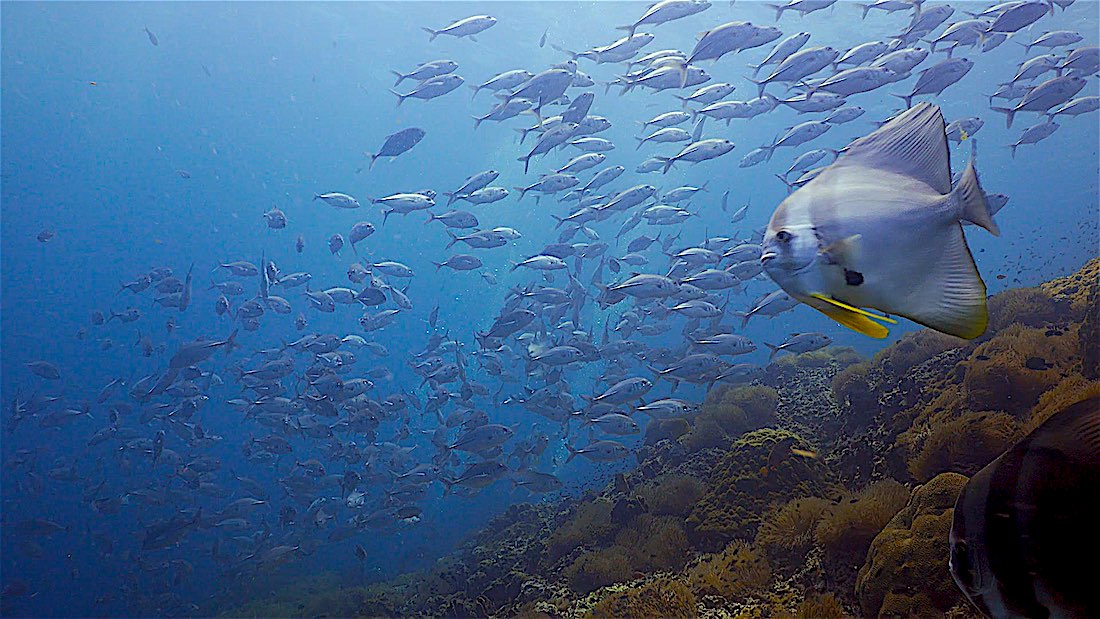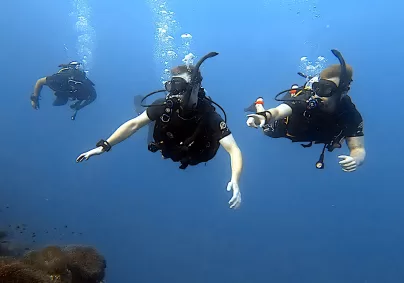Koh Tao Deep Diving Dive Sites
The island of Koh Tao has long been known as the most popular destination in the world to learn to scuba dive.
Surrounded by 8 kilometres of coral reef, with an abundance of diverse marine life and over 30 dive sites to choose from, Koh Tao caters to the needs of all divers.
Visitors to Koh Tao who want to learn to scuba dive, soon discover the most difficult part of their trip is to fit everything in, after they experience blowing their first bubbles underwater.

Explore Deep Dive Sites on Koh Tao
From beginner scuba divers to professional level scuba divers, there has always been a fascination with exploring the ocean to greater depths.
With this in mind, scuba divers can be compared to weight lifters who train to lift heavier weights. Once they reach their target, they adapt their goal and chase new personal records.
Scuba divers are similar, even without setting foot in a gym. The difference is that scuba divers tend to chase new depths.
Explore Greater Depths in the Ocean
The curiosity we have to explore the ocean pushes us to expand our skills and knowledge so that we have a larger area of the underwater environment in which to explore.
Everyone who learns to scuba dive will initially be limited to a maximum depth of 18m/60ft and for many, it is enough to explore tropical coral reefs while on a relaxing vacation.
But what if you are someone who wants to explore the deeper parts of a dive site? Or the outside of a deeper lying, sunken shipwreck?
The answer is to become a PADI Advanced Open Water Diver and then a PADI Specialty diver. The combination of these two powerful PADI diving courses is your key to exploring most of the dive sites around the world.

What is Deep Diving?
Deep diving generally refers to any dive where your maximum depth is greater than 18m/60ft. PADI considers any dive that is deeper than 18m/60ft, yet does not exceed 40m/130ft, to be a deep dive.
Forty meters is the maximum depth for recreational scuba diving, so if you want go even deeper than 40m/130ft, you need to obtain training in technical diving.
Deep diving is different because it presents a diver with additional safety concerns that generally do not exist on shallower dives. The deeper you go and the longer you stay at depth, the more nitrogen your body absorbs.
Deep diving means you need to keep a close eye on your no-decompression limit (NDL) time. Your NDL display on your dive computer will tell you how much time you can stay at your current depth.
As you descend, the time decreases, and as you ascend the time increases. You must stay within these limits otherwise you go into decompression and you must do additional safety stops on your return to the surface.
Planning Deep Dives
If you do this by accident when you have planned a no-decompression dive, you will find yourself taking unplanned safety stops and you may find yourself low on breathable gas.
This is a big problem for any responsible scuba diver. Exceeding your NDL time limits and going into decompression is not acceptable for no-decompression style of diving.
Nitrogen narcosis also becomes a concern on deep dives. It is a change in consciousness and behavior brought on by breathing compressed inert gases at depth.
Every diver doing a deep dive should be aware of the potential effects of nitrogen narcosis. While it is not physically dangerous to be in a state of nitrogen narcosis, it can slow your thought process down and make you feel confused about what it is you are supposed to be doing.
To clear the symptoms of nitrogen narcosis, a diver simply has to ascend a meter or two and take a few breaths from their tank.

Why Should I Become a Deep Diver?
Every diver at some point will find themselves on a dive site, locked at their maximum depth, looking at something below them, and thinking “I would love to be able to go and see what that marine animal is.”
This is why you should take additional training and become a deep diver. Having the additional certifications will give you access to an expansive and incredible new underwater world to explore.
The deeper you go, the more the topography and marine life changes and there are lots of Benthic dwellers and amazing marine life living below 18m/60ft.
If you are an enthusiastic PADI Open Water Diver, you should also consider becoming a deep diver for the additional skills our advanced courses teach you.
Understanding how your depth and time affect you and your dive, being able to navigate underwater, and having better buoyancy control, all help you become a better scuba diver, even if you stay shallower than 18m/60ft.

Our Best Deep Dive sites around Koh Tao
1. Chumphon Pinnacle deep dive site
Min depth: 14m/45t
Max depth: 36m/118ft
Minimum certification: PADI Advanced Open Water Diver
Distance from Koh Tao: approx. 10km to the NW
Key marine life: Barracuda, Batfish, Whalesharks & Giant Groupers
Chumphon Pinnacle is our most popular dive site and the local population of Koh Tao affectionately refer to it as ‘Chumps’.
Every morning, numerous dive boats from Koh Tao make the 45-minute journey to the submerged granite rock pinnacle and divers start entering the water as early as a few minutes after sunrise.
Many Koh Tao dive shops schedule Chumphon Pinnacle first thing in the morning, as per the recommendations to complete your deepest dive of the day first.
However, if you sleep in and catch a boat heading out to Chumphon in the afternoon instead, you may have the whole deep dive site to yourself.
Koh Tao Deep Dive Sites – Chumphon Pinnacle
Chumphon is one, large granite rock pinnacle with a few splits in the rock here and there and with good visibility, it is an imposing sight when you are descending from the surface.
Almost the entire top of the pinnacle is carpeted in soft, pink anemones that house a huge number of small and adorably aggressive anemonefish.
The sides of the pinnacle are loaded with small cracks and if you shine your torch, you may just find a moray eel looking back at you or a couple of snappy-looking crabs or shrimps.
The sand around the pinnacle is a great place to watch schools of razorfish swim around with their noses pointed downwards, almost like they have not figured out how fish are supposed to swim.

Abundance of Marine Life
It is also a great place to stare at the sea urchins and wonder how and why they seem to line themselves up in neat little patterns on the sea floor.
Chumphon Pinnacle dive site is a great place for a sunset dive and a night dive. Because the location is quite distant from Koh Tao, predators arrive at the rock pinnacle to feed after dark, and they are extra big and extra hungry.
You can see everything from an octopus chasing a crab over the field of anemones, to giant barracuda terrorizing schools of fusiliers. And since Chumphon is the dive site where we have the most whale shark sightings, a night dive here can get you the biggest scuba diving bragging rights of all – night diving with a whale shark.

Barracuda Rock at Chumphon Pinnacle Dive Site
Special treat: Barracuda Rock is situated just off the South West corner of Chumphon Pinnacle and is often home to huge schools of fusiliers and impressive-looking barracuda.
If visibility is not great, follow a compass heading of 220 degrees from the southeast corner of Chumphon Pinnacle to find Barracuda Rock.
Hot tip: Do not ignore the sandy areas at 30m around Chumphon Pinnacle. You may get lucky and see a large pipefish pretending to be a stick, or even a shark cruising silently across the bottom.

2. Southwest Pinnacle deep dive site
Min depth: 5m/16ft
Max depth: 30m/100ft
Minimum certification: PADI Open Water Diver
Distance from Koh Tao: approx. 7km to the SW
Key marine life: Whale sharks, giant green moray eels, anemones
Southwest Pinnacle is another favorite for scuba divers and it provides divers with a similar experience to deep diving at Chumphon Pinnacle.
However, the topography here offers more variation in rock pinnacle depths and a sister pinnacle that is much further away from the main dive site.
The Southwest pinnacle dive site has one main rock pinnacle in the center with smaller rock formations to the east and the west.
Southwest Pinnacle is a gorgeous dive site when visibility is great. The staggered layout of the rocks means that you can see large portions of the dive site and the marine life from almost anywhere.
The white sand that surrounds the pinnacle also gives the dive site a glowing feeling on sunny days with clear water conditions. Sometimes it can look a bit like an underwater nirvana.

Deep Open Water Dive Site
Since this is a deep open water dive site, it is common to see whale sharks at this location at certain times of the year.
Truly lucky groups of divers may see a pod of Brydes whales cresting the water while they travel to and from the dive site, or even just as they enter the water for their dive.
Seeing a pod of Brydes whales is rare, even more so if you hope to see one while diving, but it has happened in the past.
One of the more interesting but overlooked areas is a pile of rubble at 30m on the southwest side of the dive site. Marine life loves to hide and if you want to see the coolest things, you have to go and find them.
Shining your torchlight into the spaces between some of these rocks can reveal a large green moray eel staring back at you. Who does not love to meet a sea monster on a deep dive?
Secret Pinnacle at South West Dive Site
If you spend a lot of time scuba diving and deep diving around Koh Tao, you may want to explore other areas of the dive site.
The beauty of this deep open water dive site, however, is that it has a sister dive site called Secret Pinnacle, which is big enough to be a deep dive site all on its own.
To find the Secret Pinnacle, descend on the east buoy line and follow a compass heading of 120 degrees once you have the bottom in sight. If you see a tyre half covered in sand and empty wine bottles, you are heading in the right direction.
It should take you about 5 minutes of swimming to find the Secret Pinnacle but be careful not to spend too much time exploring. If your NDL time is too low for your return, you may not be able to keep the bottom in sight or stay at a safe depth.

Koh Tao Deep Dive Sites – South West Pinnacle
In conditions where there is a current or bad visibility, this may result in you missing Southwest Pinnacle upon your return.
Special treat: Squid love Southwest Pinnacle almost as much as our divers. Do your safety stop near (but at a safe distance from) the dive boat and keep your eyes open for large squads of squid using the boat as cover.
Hot tip: Ascend towards your safety stop around the main pinnacle so that you get every last second out of your dive. Keep your eyes open for the yellow boxfish that lives in the cracks.

3. Sail Rock deep dive site
* the best dive site in the Gulf of Thailand
* the most requested dive site on our boat schedule
Min depth: 0m/0ft
Max depth: 40m/130ft
Minimum certification: PADI Advanced Open Water Diver
Distance from Koh Tao: approx. 25km south east of Koh Tao
Key marine life: Giant groupers, large schools of Barracuda, Snapper & fusiliers.
Seasonal whale sharks
Sail rock is a large granite rock protruding 8 metres above the surface and dropping down where it meets the sand at around 20 metres depth.
The sand gradually banks down deeper where in three directions it meets outer lying rock formations the closest on the south east of the rock and two others on the west and south side of the rock that reach down below 35 metres.
Located approximately 25 km south of Koh Tao, half way to Koh Phan Ngan, the best dive site in the Gulf of Thailand is a 75 minutes boat ride from Koh Tao.
Sail Rock is isolated in the open, with sea currents often swirling around the rock, which creates a frenzy of marine life. What makes Sail Rock so special is the sheer abundance of marine life you will see here.

Whale Sharks at Sail Rock
Huge schools of Big eye trevally form large moving silver walls, shimmering from the rays of the sun, which pierce through the clear water.
Swirling tornadoes of yellow tailed fusiliers engulf huge areas around the rock, moving suddenly, almost as one when larger pelagic predators move in for a feast.
You will also see Yellowtail and chevron barracuda, moving around the rock in large numbers, often slower and more uniformed than other schooling species but no less spectacular.
The dive conditions at Sail Rock are variable from day to day, dive to dive and even sometimes within one dive. On occasions there is a strong current on one side of the rock but no current on the opposite side.
Likewise, the visibility can change as you navigate around the dive site, improving or deteriorating at each corner. This means even in generally poor dive conditions you can still find a sheltered corner of Sail Rock.
Koh Tao Deep Dive Sites – Sail Rock
One of the great features of Sail Rock is ‘The Chimney’, a vertical ‘swim thru’ with the entrance at 6 metres, one exit around 12 metres and a second exit at 18 metres.
Confident divers with good buoyancy control can navigate this as part of their initial descent. The opening is surrounded by lobe coral, some covered in Sea Anemones that are home to the Pink Anemone fish.
Slowly moving down through the chimney, you can see soldierfish and smaller groupers hiding in the shadows.
The dive site itself is easy to navigate, with divers dropping down to their maximum depth before circling around the rock as you gradually ascend throughout the dive.

Best Deep Dive Site in the Gulf of Thailand
At the deeper depths you will see large Malabar and Brown Marbled groupers, especially on the south west side of the rock where they tend to congregate as they look for easy prey. Here you will also see solitary Giant Barracudas looking at getting in on the feeding action too.
A closer inspection of the rock will reveal shrimps, stonefish and several popular species of nudibranch, as well as Giant and white eyed moray eels with their heads protruding out from hidden places.
There is a large school of Teira (Tailfin) Batfish which you can often see on the north side of the rock.
Special treat: Whalesharks are often seen at Sail Rock, and if you are really lucky you may see an Eagle Ray there occasioanlly as we did on a recent trip there.
Hot tip: Make your descent slowly down the chimney
Our top tips for the 3 best deep dive sites around Koh Tao will leave you wanting more as a recreational deep diver.
If you want to explore a dive site that is not on the daily boat schedules of many dive operators, our recommendation is to find a dive boat that visits Samran Pinnacle.

Bonus Deep Dive Site near Koh Tao – Samran Pinnacle
Samran Pinnacle – for experienced divers
Min depth: 13m/42ft
Max depth: 30m/100ft
Minimum certification: PADI Advanced Open Water Diver
Distance from Koh Tao: approx. 7.5km to the south
Key marine life: Nudibranchs of all types
Samran Pinnacle can be a fickle deep dive site around Koh Tao but when it is good, it is really good. The submerged set of three rocky pinnacles lies under the waves roughly halfway between Sail Rock and Southwest Pinnacle.
The granite rock pinnacles themselves are covered in soft corals and sponges and they rise up from the sea bed at 30m to reach a minimum depth of about 13m.
Samran pinnacle is a dive site that should be used by advanced divers that have completed enough dives with good buoyancy control and air consumption.
It is an unmarked dive site, meaning it has no buoy line and the boat captains have to find it using coordinates and depth finders. It is also known for having some of the strongest currents you will find on any dive site in the Gulf of Thailand.

Samran Pinnacle Deep Dive Site on Koh Tao
This means that free descents and free ascents can be particularly tricky for new, inexperienced, or unconfident divers.
Samran Pinnacle has been known to local fishermen for many years and it was an active fishing location for quite a long time. The fishermen fished there for the same reason that we deep dive there – lots of fish use Samran Pinnacle as a rest stop and as shelter from larger predators.
This dive site can often be a ‘fish soup’ and give you the experience of being a marine creature, if only for a short time.
Are you a fan of tiny nudibranchs? Then you will love a deep dive at Samran Pinnacle. Make sure to take your torch and a keen eye for alien-like creatures so that you can comb the sides of the pinnacles looking for nudibranchs that are hard to find anywhere else – like the Phidiana Indica or the Flabellina sea slug.

Diverse Marine Life
If you are looking to improve your water entry skills from a boat, Samran Pinnacle is a great place to practice negative entries (if your Divemaster or Instructor agrees, of course).
There is no buoy line for the boat to grab and the dive site often has currents, so divers cannot waste time on the surface otherwise they may miss the dive site in poor visibility.
A negative entry is when you enter the water with an empty BCD (Buoyancy Control Device) and begin your descent immediately.
It is a great skill to learn to help you bypass surface conditions and visit unmarked dive sites, however, it is a skill that should be supervised by a dive professional and performed only by experienced divers.
Indeed, it is a skill that is useful on a scuba diving liveaboard trips to the Andaman Sea and Similan Islands.
Special treat: Very few dive centers on Koh Tao visit Samran Pinnacle so when you are there, you are often the only boat.
Hot tip: Pick up a tank of Nitrox for your dive at Samran Pinnacle. You will appreciate the extended bottom time.

Get Certified to Dive Deeper – PADI Deep Diver Course
Our PADI Deep Diver Course will teach you everything you need to know to safely dive deeper than 18m/60ft, but not deeper than 40m/130ft.
The course takes place over 2 days and includes 3 or 4 deep training dives. It is taught in two sections – class-based knowledge development and actual open water training dives.
At Black Turtle Dive, we take our customer experience very seriously. We build your confidence and competence with new skills and never force you to do something you are not ready for.
Individually, our highly-trained and attentive diving instructors limit student groups to no larger than 4 people and we give you exactly the right amount of personal attention you need to bring out the best in you as a scuba diver.
Prerequisites
- PADI Advanced Diver
- recent diving experience (within the last year)
- minimum 15 years of age
- medically fit to dive.
Interested in upgrading to a PADI Deep Diver? Check out our website for more details on the course itself and get in touch to book your PADI Deep Diver Course today.
Frequently Asked Questions
Where are the best deep diving sites on Koh Tao?
The best deep diving sites are Sail Rock, Chumphon Pinnacle, South West Pinnacle. Whilst divers have their own preferences, in our experience, these are the most popular deep dive sites around Koh Tao.
What is the maximum depth for a recreational deep diver?
40 metres is the maximum depth for recreational deep diving and to go deeper, divers need to get additional training in technical diving.
Is Deep Diving Safe around Koh Tao?
Recreational deep diving is very safe with a dive plan and as long as you follow the extra considerations for divers when diving deeper. Plan your dive and stay with the plan.
How do I become a Deep Diver?
Divers need to learn additional skills as an advanced diver and then consider a deep diving specialty course, which will give you all the knowledge you require to manage and plan deep dives safely.







